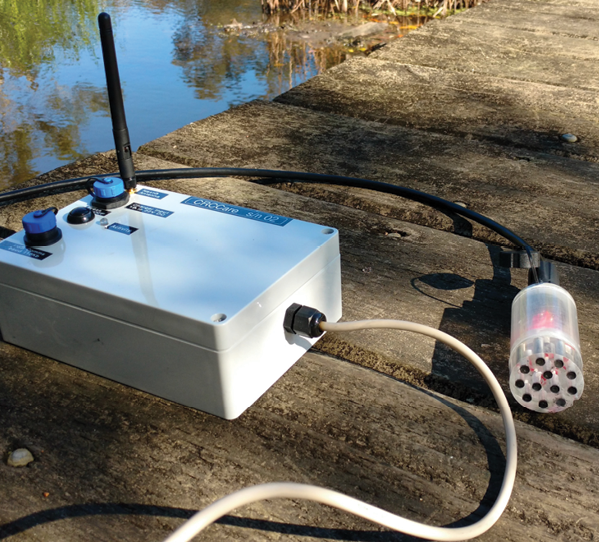Controlling the quality of irrigation water is important for crop and plant growth. Water quality can be monitored in situ using an ion-selective electrode (ISE) array with suitable data processing algorithms. CRC CARE has developed a novel technique – the probeCARETM system – for measuring ions in solution, using ISE arrays1-2 and software that allows real-time measurement.
The probeCARE system can measure common ions – such as sodium (Na), potassium (K) and calcium (Ca) – in complex solute matrices, even in coloured solutions. This is of value to agricultural irrigators, and for monitoring water quality in lakes and streams.

The probeCARE unit in use onsite
Advantages of probeCARE
Existing techniques for measuring water quality use laboratory equipment that is too large and heavy to use in the field. In addition, the processing times and equipment costs are prohibitive. The probeCARE system is small and portable. It uses probes with wireless data loggers, and the mobile phone network sends data from the field to a computer.
Currently, for online in situ monitoring of irrigation water qualities, only information such as pH, electrical conductivity (EC) and total dissolved salt content can be measured. Individual components of the nutrient solution cannot be simultaneously monitored. By using the probeCARE system, all the essential macroelements in irrigation water such as Ca, chloride (Cl), nitrate (NO3), K and Na can be simultaneously measured, within acceptable error ranges.
These qualities make probeCARE a cost-effective, fast and accurate technology.
Real-world application: using probeCARE to create an intelligent fertigation system
Fertigation is the application of liquid fertiliser into irrigation systems. Liquid fertilisers are injected directly into the irrigation water and carried to the plant root zone. Inorganic fertilisers are usually used with fertigation systems, because inorganic fertilisers have the advantage of being quick-release formulations that allow nutrients to become rapidly available to plants.1
However, the disadvantage of inorganic fertilisers is that nutrients are also easily leached from the soil by rain or excess irrigation.3 When fertilisers are applied to fields, the plants do not use it all. Excess fertiliser infiltrates the soil and accumulates in aquifers. Therefore, to avoid excess use of inorganic fertilisers, recycling the water and fertiliser are important components of the fertigation system.
To optimise crop production, it is necessary to know the type and quantity of fertilisers to be added to the fertigation system at each stage of plant growth. To control several fertilisers that need to be added to the system, the water quality of the irrigation water sources must be understood in real time. Furthermore, after fertilisers are injected into the system, the final water quality carried to the plant root zone has to be determined. Therefore, real-time, in situ water quality monitoring is essential.
The probeCARE system can measure the responses from the ISE array in any unknown solution and predict the concentration directly using the novel pattern recognition procedure. To determine irrigation water quality, two important indexes are used:
- salinity, which is the total soluble salts in the water
- sodicity, measured as the sodium adsorption ratio (Na + K : Ca + Mg).
Inorganic fertilisers contain the primary macronutrients NO3 and K.
Therefore, 6 important elements should be monitored by the fertigation system: Ca, Cl, Mg, NO3, K and Na. These microelements, which are commonly found in high concentrations in irrigation waters, are essential for determining water quality and influencing crop yield, soil productivity and environmental contamination. Unfortunately, when using traditional techniques for analysis, the interaction and interference that occur among these elements in environmental samples may severely limit the application of ISEs.4,5 However, determining these elements simultaneously and directly using the probeCARE system may offer a way to develop an intelligent fertigation system.
Other potential applications
The probeCARE system gives fast and accurate results that can be used:
- in agronomy and horticulture
- to support management strategies for cropping, fertigation and effective use of recycled water
- to monitor for possible pollutants to ensure environmental protection agency standards are achieved
- as a real-time nutrient monitoring system for many vegetable crops
- to analyse irrigation water quality
- in natural environment management, such as for waste water management
- as a nutrient monitoring system for freshwater waterways and reservoirs.
In addition, probeCARE is being developed with internet connectivity to support remote sensing and continuous monitoring of critical resources. The technology is in the early stages of commercialisation, but its commercial potential is likely to improve in the medium to long term.
References
- Naidu R, Wang L, Chen Z, Megharaj M. Analyte ion detection method and device. Patent application PCT/AU2011/00166, publication no. WO2012083371 A1, 2012.
- Naidu R, Wang L, Chen Z, Megharaj M. Application of mathematical models and genetic algorithm to simulate the response characteristics of an ion selective electrode array for system recalibration, provisional patent application no. 2015900933, 2015.
- Palm C, Myers R, Nandwa S. Combined use of organic and inorganic nutrient sources for soil fertility maintenance and replenishment. Replenishing Soil Fertility in Africa 1996:193–217, doi:10.2136/sssaspecpub51.c8.Carrow R, Duncan RR, Huck MT. Turfgrass and landscape irrigation water quality: assessment and management, CRC Press, Boca Raton, Florida, 2008.
- Ivanova NM, Levin MB, Mikhelson KN. Problems and prospects of solid contact ion-selective electrodes with ionophore-based membranes. Russian Chemical Bulletin 2012;61:926–936.
- Lindner E, Gyurcsányi R. Quality control criteria for solid-contact, solvent polymeric membrane ion-selective electrodes. Journal of Solid State Electrochemistry 2009;13:51–68.